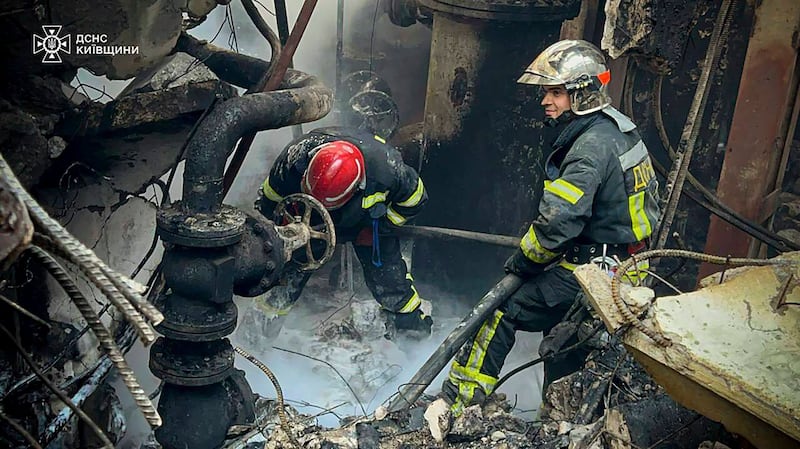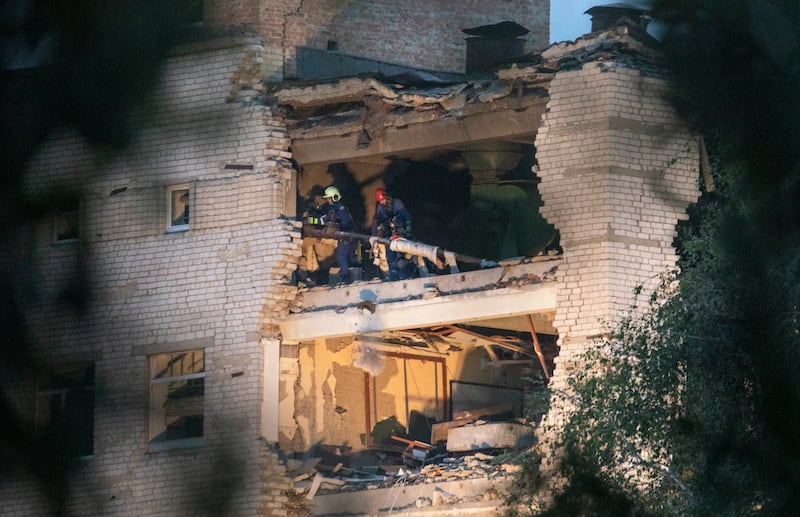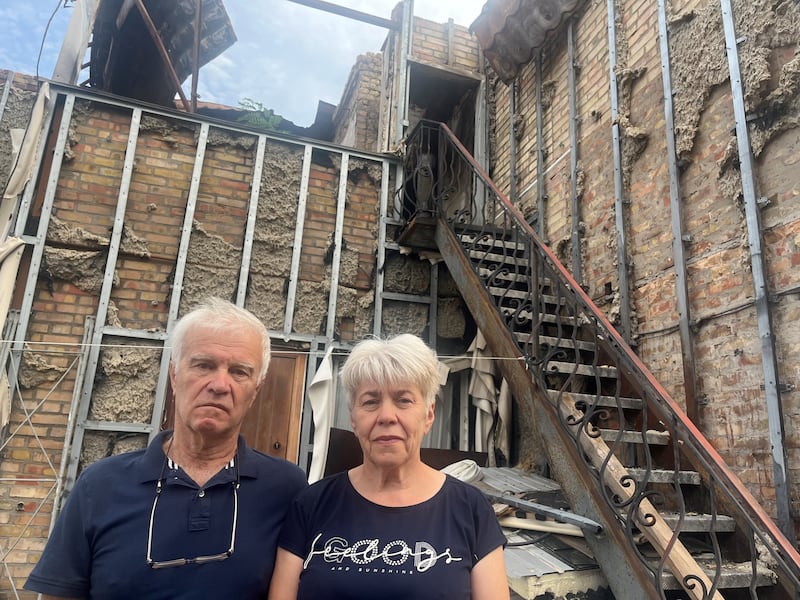In the bowels of the Trypilska power plant outside Kyiv, several crews of workers are welding and hammering away, in an effort to repair the huge facility that was badly damaged by Russian missiles earlier this year.
The power plant was one of the biggest suppliers of energy to the Ukrainian capital and surrounding regions, before it was taken completely out of action by Russian strikes in April.
Fires that engulfed the site after it was hit by Russian missiles left the inside of the facility a smouldering shell. The power plant, which will probably take years to restore to full capacity, was targeted as part of Russia’s efforts to starve Ukraine of electricity, as the brutal war heads into its third winter.
Bombings of Ukrainian cities and critical energy infrastructure have sought to turn the screw on the civilian population, with air-raid sirens and alerts on smartphone apps about incoming missiles and drones a feature of day-to-day life.
RM Block
Residents in Kyiv often have to make do with several hours of electricity in their homes a day. In the streets of the capital this week people were going about their lives in the sunshine, but the weather will soon turn.

Closer to the front lines in the east of the country, the intense bombing of urban centres in cities such as Kharkiv has left humanitarian organisations particularly concerned about the coming cold months.
“We are extremely worried about the upcoming winter,” says John Wain, who co-ordinates the provision of shelter in Ukraine for the United Nations’ Refugee Agency. “We need to raise the flag and put out the alarm that we need additional funding to be able to ensure that Ukrainians can survive the upcoming winter, where temperatures will drop in some areas to as low as minus 20 degrees.”
Attacks on critical infrastructure meant the supply of energy in Ukraine was much more strained this year, says Wain. “Ukrainians are used to winter, [but] with the damage to infrastructure they are not going to have the central heating systems as much as they would have in a normal time. Once we get to the end of September we will be firmly in the crosshairs in terms of winter.”
Families in rural homes will be able to keep warm around a stove, with aid agencies planning to provide funds to help people buy firewood. “The big challenge will be the millions and millions of people who live in multistorey apartment blocks, who cannot necessarily burn fuel. It is going to be a massive challenge for us as winter sets in,” says Wain.
Critical facilities, such as Trypilska power plant, can only be properly protected by air defences able to shoot down Russian missiles and drones, something Ukraine has long complained to its western allies that it is sorely lacking.
Ukrainian president Volodymyr Zelenskiy has repeatedly pleaded with the United States, the UK and other European countries for donations of Patriot air defence systems. The Ukrainian leader has also pressed for permission to use long-range missiles supplied by the US and others to hit airfields and other military targets deep in Russian territory.
Amanda Paul, a senior analyst at the European Policy Centre, says Ukraine is in a “pretty precarious situation” at this point in the war. Its allies “keep making big promises but not delivering”, as it seems political fatigue is setting in, she says.
Ukraine will be left in a “desperate place” if Donald Trump is elected to the White House, raising the prospect of US support being withdrawn or cut significantly back, says Paul. Europe will not be able to pick up the slack in a scenario where the US pulls its military aid to Ukraine during a second Trump presidency, she adds.
The surprise advance Ukrainian troops recently made into Russia to take the western city of Kursk has been seen as a rare win, boosting morale of troops who are increasingly worn down. But at the same time Russia has been advancing in eastern Ukraine towards Pokrovsk, a city seen as a strategic position to hold in the Donbas region.

As Ukrainian politicians repeat calls for their western backers to do more, Russia has continued to bombard cities with drones and other missiles. Earlier this week a woman and her three young daughters were among several killed by Russian bombs in Lviv, the western city near the Polish border. The day before more than 50 were killed in strikes in Poltava in central Ukraine, with nearly 300 others injured.
In Borodyanka, a town outside Kyiv, crumbling apartment blocks are a stark reminder of the threat facing the civilian population. It was heavily bombed during the initial advance on the capital after Russia invaded in February 2022. Of about 30,000 buildings destroyed as Russian forces rolled through the area, so far about 17,000 – mostly residential homes – have been rebuilt, according to Ruslan Kravchenko, a Ukrainian official in the Kyiv regional administration.

Mykola and Nataliia Anisimov, a couple who live in nearby Hostomel, fled the Kyiv region when Russia invaded. Like tens of thousands of other Ukrainian refugees, they made their way across the border to Poland, as Russian tanks and troops streamed into Ukraine. When they were able to return after the Russian advance on Kyiv had been repelled, they found their home had been gutted by heavy shelling.
Today, bare walls of exposed bricks, a steel staircase, and piles of rubble and debris on the ground are all that remain of the house where the family had lived for decades. Iron fences along the road are pockmarked with holes from falling shrapnel in those first days of intense fighting on the outskirts of the Ukrainian capital.
“This became the frontline, and then serious attacks started,” says Natalia Anisimov. The family had been determined to remain on the land. Earlier this summer a project funded by Irish Aid was able to build the family a prefabricated modular home that was placed beside the wreck of their former home.
In parts of the country that had been occupied by Russia and later retaken by Ukrainian forces, civilians still risk coming across traps left behind by the retreating army. “As they withdrew they booby-trapped houses and they booby-trapped buildings,” said David McMahon, who leads a UN project to train Ukrainian authorities in demining.
Rigged household objects left on a table could be fatal if moved, so each building had to be cleared. “We’ve one example that took over two months to clear one building and they found over 20 devices,” he says. The vast fields of agricultural land could also be hiding minefields. “The mine belt that is now between here and Russia, it is going to take an awful, awful long time to clear.”
- Sign up for push alerts and have the best news, analysis and comment delivered directly to your phone
- Find The Irish Times on WhatsApp and stay up to date
- Our In The News podcast is now published daily – Find the latest episode here
























